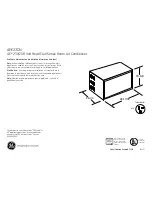
18
Heat Pumps and Energy Savings
• GE Zoneline
®
heat pumps are designed to provide
cost-efficient heat pump operation while monitoring
room conditions to maintain comfort.
The units employ a logic system monitoring both outdoor
and indoor temperatures to determine the heat source, thus
increasing energy savings by operating longer in the heat
pump mode.
Heat pumps save energy and cost less to operate than
units with electric resistance heaters as the only heat source.
Just as the EER of an air conditioner is an indication of the
efficiency of the unit, COP (Coefficient of Performance) is the
indication of the efficiency of the heat pump. This relative
efficiency of a heat pump compares the unit to electric
resistance heat. If a unit has a COP of 3.0, it means the
unit will produce three times as much heat at rating
conditions for the same electrical input wattage used
for electric resistance heat.
The compressor is used in heat pump operation just as
in air conditioning operation. In heat pump operation,
the hot refrigerant gas is directed to the indoor coil rather
than to the outdoor coil. Room air that circulates over the
indoor coil gains heat from the coil rather than losing heat
to the coil as during cooling operation.
As the outdoor temperature falls, the heat pump is able to
extract less heat from the outdoor air to raise the temperature
of the indoor air. For this reason, all packaged terminal heat
pumps also have electric resistance heaters as backup to heat
pump operation. At some point, the heat pump is unable to
provide sufficient heat to adequately warm the room. Many
Packaged Terminal Heat Pumps cease heat pump operation
and change to more expensive resistance heat at some
pre-determined outdoor temperature to compensate for
the inability of the heat pump to maintain room temperature.
This point, called the “switchover point,” is usually at an outdoor
temperature where savings from heat pump operation may
still be realized if the unit is designed to maintain room comfort
at the lower outdoor temperatures.
Balance Point
An important consideration in the selection of a heat pump
unit is the “balance point” of the installation. Virtually every
room is unique—with different insulation, different sizes
and types of windows, different types of construction,
different directional exposures. All these variables, as well
as geographical location, must be considered in order to
determine the balance point, the point at which the heat pump
is unable to produce enough heat to compensate for the heat
loss of the room or area being heated. For these reasons a
consulting engineer should be engaged to calculate the heat
loss and specify the heat pump unit required.
GE offers the 6100 series of Zoneline heat pump units—with
highly featured microprocessor controls—react to the
indoor temperature as well as the outdoor temperature in
determining the heat source to provide comfortable room
conditions and energy savings. This determination of the heat
source based on the indoor temperature helps provide a more
comfortable room.
Содержание 4100 Series
Страница 46: ...Typical 4100 Series 230 208 Volt Wiring Diagram 46 ...
Страница 47: ...47 geappliances com Typical 4100 Series 230 208 Volt Schematic Diagram ...
Страница 48: ...48 Typical 6100 Series 230 208 Volt Wiring Diagram ...
Страница 49: ...49 geappliances com Typical 6100 Series 230 208 Volt Schematic Diagram ...
Страница 57: ...57 geappliances com Notes ...
Страница 58: ...58 Notes ...
















































